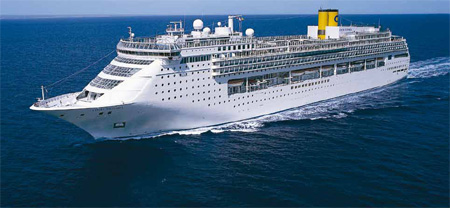Steering a new course
Updated: 2011-10-21 09:02
By Lin Jing and Li Xiang (China Daily)
|
|||||||||
|
|
The lure of adventure at sea and on land are turning China into a cruise industry drawcard
The well plied waters of the Caribbean and the Mediterranean, the South Pacific and Alaska may have had their heyday, and the seas of China loom on the horizon. It used to be that for anyone planning to see a bit of the world in splendid luxury the first port of call was a travel agency, where they would be treated to colorful, glossy brochures replete with images of sun-filled skies, glistening blue seas, palm trees, pristine fjords and snow-capped peaks. But things have begun to change, and China, land of history and culture, is beginning to stake its claim in the market for cruise tourism. If that is not good enough for those in the cruise industry, they can bask in the fact that more and more increasingly affluent Chinese are opting to relieve their tensions - and empty their pockets - on the high seas.
| ||||
"China's cruise market is attracting tourism both at home and abroad," says Qian Yongchang, president of the China Communication and Transportation Association. "Cruises have become a new way of holidaying for Chinese people Cruise tourism in China is set for exponential growth over the next two or three years."
His enthusiasm is echoed by Michael Bayley, executive vice-president of Royal Caribbean Cruises Ltd, a cruise operator in Miami, and Liu Chenjun, vice-president of strategy and business development with Costa China.
At present international cruise ships call at more than 20 Chinese ports, the China Cruise and Yacht Industry Association says. Last year 223 such ships berthed in China, an increase of 43 percent on the previous year.
Of the 223, 95 began their voyages in China. The number of inbound and outbound mainland cruise travelers was 790,000 last year, up 20 percent on 2009. There were 462,000 inbound foreign travelers, up 15.5 percent.
Next year Royal Caribbean will introduce Voyager of the Seas into China, servicing 20 itineraries from the country. Another ship, Legend of the Seas, will be back in China in March, its fourth visit in as many years. The two ships, departing from Tianjin, Shanghai and Hong Kong, will service about 50 itineraries, the destinations being Asian countries, including Japan, the Republic of Korea and Singapore.
The arrival of Voyager of the Seas, one of the world's largest cruise ships, will help Royal Caribbean cover two regions, Northeast China and North China, in peak periods, says Liu Zinan, managing director of Royal Caribbean Cruises, China and Asia-Pacific region.
It will be the first time Royal Caribbean has operated two ships in China simultaneously, he says.
Costa Crociere SpA, the largest cruise company in Europe and, which was the first foreign cruise company to operate in China, also plans to double its China fleet, bringing one more ship, the 75,000-ton Victoria to the country.
Costa Crociere, which started operating in China in 2006, says it has enjoyed annual double-digit growth since then. Costa China's Liu Chenjun says that relative to GDP, China surpasses Latin America and the Caribbean in its contribution to the company's coffers.
Nevertheless, the number of vessels operating in China is still relatively small, he says. Nineteen vessels ply the waters of South America, compared with only a handful in China.
Since China is the second largest economy and is a big consumer of luxury goods, that leaves a lot of scope for expansion, Liu says.
One factor propelling the enthusiasm for China in the cruise industry is that the traditional markets of North America and Europe have become saturated.
"International cruise companies are shifting their focus to Asia, especially China, because of our fast growing economy and substantial consumer potential," says Song Dexing, director-general of the water transport department in the Ministry of Transport.
But for Ye Jian, president of China Association of Port-of-Entry, there is more to it than that.
"In conventional destinations such as the Caribbean, certain cruises have remained unchanged for decades. Those stale routes have lost their attraction to consumers, and that makes it more difficult to expand the market. As for Alaska, it has enacted strict laws restricting the number of cruise ships so as to protect the local glacier environment."
While the physical beauty of a destination is one obvious selling point of a cruise, he says that what China has to offer is its unique lifestyle and rich history and culture.
"As a result of the 2008 Beijing Olympics and Shanghai Expo 2010, China's profile has been lifted considerably, and more tourists are willing to come here on Asian trips."
Besides culture, China's location has endowed it with a key role in the international cruise market.
Chinese ports serve as important departure points and destinations for summer cruise voyage in Asia, and also major ports of call for winter cruises.
For Royal Caribbean's Michael Bayley, in the business for 30 years, 10 of them working on ships, the attraction to Westerners of encountering Chinese culture is manifest. It is "old, established and esteemed", he says
While an exotic culture has undoubted allure to would-be cruise passengers, the companies have to negotiate difficult shoals in meeting customer needs. Serving up dreams on a platter is one thing, but they also have to be aware that many of their customers, apart from enjoying the new, want to do that in the comfort they are accustomed to.
That is where adapting cruises to the style and cultures of the customers comes in. In Costa's quest for Chinese customers it makes a point of having Chinese-speaking crew and Chinese menus on its ships. Taking account of the holiday habits of Chinese also comes into the reckoning.
Unlike people in Europe and the US, where holidays can be flexible and long, Chinese have much shorter ones. And paid annual leave is a treat for the minority in large cities, says Liu Chenjun, vice-president of Costa.
"Over the next year we will design short voyages of three to seven days, taking passengers to famous tourist destinations in nearby countries such as Japan and South Korea."
MSC Cruises, a family owned European company, and one of the top four cruise operators in the world, has plans to provide a lot more choice in its offerings to Chinese.
"Product diversification has great market potential," says Helen Huang, general manager of MSC Cruises Travel Agency (Shanghai) Co.
MSC has an 11-vessel fleet, and says that it has more than 1 million passengers worldwide every year. The company entered China by setting up a jointly funded travel agency with Shanghai International Port Group in 2009.
Huang says that in China 90 percent of cruise travel agencies sell only cruises that set out from and return to China, and the sameness of the offerings means the competition can be cut-throat.
In that atmosphere diversifying is seen as a lifebuoy, and MSC is trying to provide more customized products for young and wealthy consumers in China. MSC expects its long-haul business in China to double in each of the next two years.
While the cruise operators are enjoying their success of the past few years, many challenges remain, including introducing the uninitiated to what Huang calls cruise culture.
"Promoting cruise culture and informing people about its lifestyle is important for us, especially in second- and third-tier cities, which have less buying power."
And Huang believes it is not just unsophisticated land lubbers who need educating. "Improvement is needed in the way travel agencies market diversified cruise products. Consumer demand needs to be created, nurtured and channeled."
The company plans to introduce a cruise ship into China by 2014, says Zhang Yu, North China business development director with MSC.
"The facilities and number of crew will be the same no matter whether the ship is fully loaded or not. If there are not enough passengers, we are the losers. So before our ship arrives we have to do enough marketing to make sure there are enough local customers."
The company plans to set up agencies in second- and third tier cities to increase ticket sales. In the coming year it will open six agencies.
Buhdy Bok Sin Swee, vice-president of Costa China, echoes Huang in saying that despite China's huge potential, cruise companies still need more promotion.
There is at least one more player in all of this. The central government is trying to provide a favorable policy environment to smooth foreign companies' local development.
Since last year the Ministry of Transport has started to formulate laws on foreign cruise companies setting up solely funded operations in China.
In August, after agreement was reached by the Ministry of Transport and the Ministry of Commerce, a paper on "strengthening the approval process for wholly foreign-invested shipping companies" was issued.
The Ministry of Transport's Song Dexing says such policies will allow approved foreign operators to have their wholly owned subsidiaries here, which will help them attract passengers.












